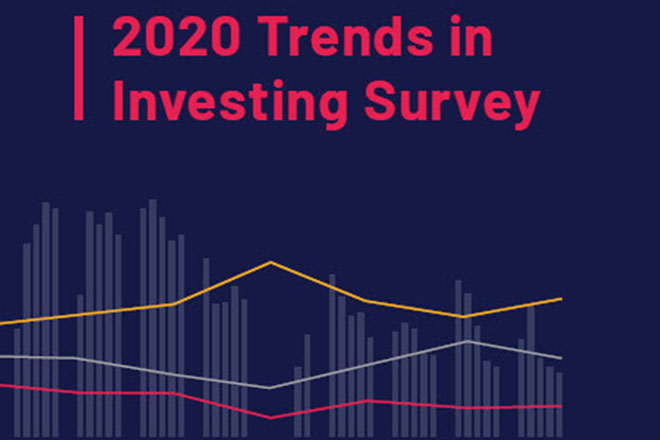Knowledge. Shared Blog
June 2020
2020 Trends in Investing: Uncertainty Forces Financial Professionals to Reevaluate Asset Allocation
-
 Adam Hetts, CFA
Adam Hetts, CFA
Global Head of Portfolio Construction and Strategy
The 2020 Trends in Investing Survey, which Janus Henderson conducted in conjunction with the Financial Planning Association® (FPA®) and the Journal of Financial Planning, reveals that the pandemic is directly impacting financial professionals’ short-term economic outlook. Global Head of Portfolio Construction and Strategy Adam Hetts explains what the findings mean for how financial professionals approach asset allocation and portfolio rebalancing during times of chaos.
For the first time, Janus Henderson partnered with the Financial Planning Association® (FPA®) and the Journal of Financial Planning on their annual Trends in Investing Survey. Considering the extreme market volatility and economic uncertainty that dominated the first few months of 2020, it turned out to be a rather opportune period in which to be involved in this type of research.
Not surprisingly, the 2020 Trends in Investing Survey, which FPA has conducted since 2006, revealed that financial professionals are feeling bearish about the market and economic outlook for the next six months. Financial professionals also reported that clients are asking about the effects of general volatility and COVID-19 on their portfolios.
The timing of the survey offered a unique opportunity to gauge how financial professionals’ six-month economic outlook shifted dramatically as the crisis was just beginning to intensify. (Note: President Trump declared a national state of emergency on March 13, and we started collecting responses on March 7.) Results from March 7-13 showed financial professionals were generally neutral or somewhat bearish, with just 12% bearish. After March 13, nearly one-third of financial professionals said they were bearish on the outlook for the U.S. economy (31%).
The survey’s findings on asset allocation were especially telling: Overall, more than half (57%) of respondents said they typically reevaluate their asset allocation strategy based on the economy in general, while 52% do so based on market volatility. However, when we look at the responses to this question for the period of March 13 through April 1, those percentages jumped considerably, with 64% reevaluating asset allocation due to the economy and 58% doing so in response to market volatility.
The dramatic price swings that occurred across asset classes during those volatile weeks in March clearly had an impact on financial professionals’ asset allocation strategies. Those moves also led to an unusually large volume of rebalancing inquiries for the Portfolio Construction and Strategy (PCS) Team here at Janus Henderson. Over the course of our consultations, we have seen a few specific concepts resonate with clients regarding how to best approach portfolio analysis during a time of chaos. We have shared these concepts here previously in greater detail; following is a brief overview:
A Sell-Off Doesn’t Change Everything
In our view, rebalancing, diversifying and/or reallocating during a downturn should follow the same process as during less volatile markets: Gauge performance against various benchmarks, assess drawdown potential versus investor suitability, identify intended and unintended concentrations and gaps, remedy as needed, rinse and repeat. In other words, the short-term environment should not allow market-timing impulses to be the driving force behind reallocation.
View Sunk Costs from a Blank-Slate Perspective
Extreme losses might lead to a “Well, I can’t sell now” perspective. Going back to the general reallocation process outlined above, financial professionals should examine these exposures by asking, “If I were building a portfolio from a blank slate, would I buy this exposure at this price level at these levels of uncertainty?” This blank-slate approach can offer much-needed perspective and a reprieve from the regret that investors may be feeling in the wake of this sell-off. Barring special circumstances related to taxes (more common) and illiquidity (less common), incumbent losses are nothing more than sunk costs that should be ignored.
Start at the Beginning
Amid extreme market turmoil, another helpful way to cut through the noise is to start at the beginning. The original target allocation set for an investor is what was determined to be that individual’s optimal long-term asset allocation. A portfolio drifted by market movement is, by definition, suboptimal, being underweight recent losers and overweight recent winners and adding, essentially, a “momentum” trade to the portfolio. Is this momentum trade part of the original plan? If not, is it worth the cost to rebalance? These dilemmas are not specific to rebalancing – they are what any investor faces when making asset allocation decisions.
A Consistent Framework for Portfolio Analysis
Going back to the Trends in Investing Survey results, 66% of respondents stated that they continually reevaluate their asset allocation strategy. When faced with today’s unprecedented volatility and uncertainty, this process takes on heightened importance and may cause some financial professionals to question their traditional approach. But in our view, the framework used to analyze portfolio moves – large or small – is always the same.
When reassessing clients’ asset allocation in a time of crisis, we recommend financial professionals start by identifying and diagnosing the portions of a portfolio that are experiencing losses: Of these losses, which are merely unusual and which are unacceptable? Then, when it is time to rebalance, we believe it is prudent to use the same reallocation principles as they would follow in less volatile markets, with an eye toward both current portfolio positions and baseline asset allocation.
Rebalancing is not a generic question with a universal answer; it depends on specific asset allocations and portfolio goals. Our proprietary portfolio risk analytics are designed to help drive toward an answer tailored to an investor’s specific situation. For help, consider engaging our PCS team so that we can extend these tools to you.
2020 Trends in Investing Survey
Conducted by the Journal of Financial Planning® and the Financial Planning Association® (FPA), and sponsored by Janus Henderson Investors.
Download Now
Knowledge. Shared
Blog
Back to all Blog Posts
Subscribe for relevant insights delivered straight to your inbox
I want to subscribe